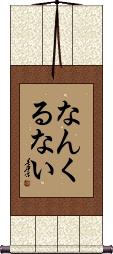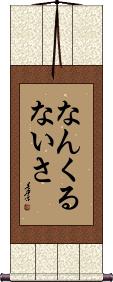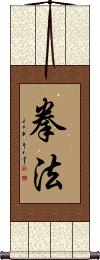Many custom options...
And formats...

Ryukyu in Chinese / Japanese...
Buy a Ryukyu calligraphy wall scroll here!
Personalize your custom “Ryukyu” project by clicking the button next to your favorite “Ryukyu” title below...
Ryukyu
Ryukyu Kobujutsu
Okinawan Kobudo
Ryukyu Kempo
Don't Worry, Be Happy
なんくるない or nankurunai is an Okinawan word, written in Japanese that means “Don't worry, be happy.”
沖縄/Okinawa and/or the 琉球/Ryūkyū Islands have a more laid-back “island style” approach to life. So the nankurunai idea is a perfect match for that lifestyle.
Note: Because this title is entirely Japanese Hiragana, it should be written by a Japanese calligrapher.
Nankurunaisa
Everything will be all right, it will all work out one way or another
なんくるないさ or Nankurunaisa means “Everything will be all right” and/or “It will all work out one way or another.”
なんくるないさ is an Okinawan (琉球 / Ryūkyū Islands) word written in Japanese.
You might see this romanized with breaks like nankurunai-sa or nankuru-nai-sa. It's the same word either way. However, there is a separate word, なんくるない, in there which is nankurunai, translated as “Don't worry, be happy.” The “sa” or さ part indicates an assertion or interjection.
Note: Because this title is entirely Japanese Hiragana, it should be written by a Japanese calligrapher.
Kenpo / Kempo / Quan Fa / Chuan Fa
拳法 is a form of martial arts that can be translated in several ways.
Some will call it “fist principles,” “the way of the fist,” or even “law of the fist.” The first character literally means fist. The second can mean law, method, way, principle, or Buddhist teaching.
Kempo is really a potluck of martial arts. Often a combination of Chinese martial arts such as Shaolin Kung Fu with Japanese martial arts such as Karate, Jujutsu (Jujitsu), Aikido, and others. You may see the term “Kempo Karate,” which basically means Karate with other disciplines added. In this way, Kempo becomes an adjective rather than a title or school of martial arts.
These facts will long be argued by various masters and students of Kempo. Even the argument as to whether it should be spelled “kenpo” or “Kempo” ensues at dojos around the world (the correct Romaji should actually be “kenpou” if you precisely follow the rules).
The benefit of Kempo is that the techniques are easier to learn and master than pure Kung Fu (wu shu). Students are often taught basic Karate moves, kicks, and punches before augmenting the basic skills with complex Kung Fu techniques. This allows students of Kempo to achieve a level where they can defend themselves or fight in a relatively short amount of time (a few years rather than a decade or more).
Because the definition of this word is so fluid, I should make some notes here:
1. Purists in Okinawa will claim that “Okinawa Kenpo” or “Ryukyu Hon Kenpo” is the original and true version of this martial art from the old kingdom. It is actually little or no connection between Okinawa Kenpo and the way the word is used elsewhere.
2. In Chinese, where these characters are pronounced “quan fa” (sometimes Romanized as “chuan fa” because the Chinese-pinyin “q” actually sounds like an English “ch” sound), these characters do not hold the connotation of being a mixed martial art. It is simply defined as “the law of the fist.”
3. My Japanese dictionary oddly defines Kenpo as the “Chinese art of self-defense.” I personally don't feel this is the most common way that people perceive the word but just something you should know.
Not the results for ryukyu that you were looking for?
Below are some entries from our dictionary that may match your ryukyu search...
| Characters If shown, 2nd row is Simp. Chinese |
Pronunciation Romanization |
Simple Dictionary Definition |
琉球 see styles |
liú qiú liu2 qiu2 liu ch`iu liu chiu ryuukyuu / ryukyu りゅうきゅう |
More info & calligraphy: Ryukyu(See 沖縄) Ryukyu; chain of southwestern Japanese islands comprising Okinawa Prefecture; (place-name) Ryūkyū |
琉球古武術 see styles |
ryuukyuukobujutsu / ryukyukobujutsu りゅうきゅうこぶじゅつ |
More info & calligraphy: Ryukyu Kobujutsu |
八巻 see styles |
yamaki やまき |
(hist) turban-like hat worn by officials in the Ryūkyū Kingdom; (surname) Yamaki |
刺鼠 see styles |
togenezumi とげねずみ |
(kana only) Ryukyu spiny rat (Tokudaia osimensis) |
劉虬 刘虬 see styles |
liú qiú liu2 qiu2 liu ch`iu liu chiu Ryūkyū |
Liuqiu |
尚氏 see styles |
shoushi / shoshi しょうし |
Shō clan (royal family of the Ryukyu Kingdom) |
按司 see styles |
aji; anji; anzu あじ; あんじ; あんず |
(hist) chieftain (of the Ryukyu Kingdom) |
棘鼠 see styles |
togenezumi とげねずみ |
(kana only) Ryukyu spiny rat (Tokudaia osimensis) |
殿内 see styles |
tonouchi / tonochi とのうち |
(honorific or respectful language) (hist) (rkb:) residence of a government official in the Ryukyu Kingdom; (surname) Tonouchi |
流求 see styles |
ryuukyuu / ryukyu りゅうきゅう |
(place-name) Liuqiu (Chinese name for islands in the East China Sea, perhaps referring to Ryukyu or Taiwan); Lewchew |
流球 see styles |
liú qiú liu2 qiu2 liu ch`iu liu chiu |
variant of 琉球[Liu2 qiu2], Ryūkyū, e.g. the Ryūkyū Islands 琉球群島|琉球群岛[Liu2 qiu2 Qun2 dao3] stretching from Japan to Taiwan |
王府 see styles |
wáng fǔ wang2 fu3 wang fu oufu / ofu おうふ |
prince's mansion (archaism) royal government (esp. Ryukyu Kingdom) |
球陽 see styles |
kyuuyou / kyuyo きゅうよう |
(1) (hist) official history of the Ryukyu Kingdom (compiled between 1743 and 1745); (2) (See 琉球) Kyūyō (poetic name for the Ryukyu Islands) |
琉久 see styles |
ryuukyuu / ryukyu りゅうきゅう |
(surname) Ryūkyū |
硫球 see styles |
liú qiú liu2 qiu2 liu ch`iu liu chiu |
Luzon, island of the Philippines; the Ryukyu islands |
赤髭 see styles |
akahige あかひげ |
(1) (kana only) red beard; person with a red beard; (2) (derogatory term) Westerner; (3) (kana only) Ryukyu robin (Erithacus komadori); (surname) Akahige |
赤鬚 see styles |
akahige あかひげ |
(1) (kana only) red beard; person with a red beard; (2) (derogatory term) Westerner; (3) (kana only) Ryukyu robin (Erithacus komadori) |
間切 see styles |
magiri まぎり |
(irregular okurigana usage) (1) sailing windward; (2) (obsolete) land division in the Ryukyu Kingdom equivalent to modern prefectures (but the size of cities or towns) |
雀鯛 see styles |
suzumedai; suzumedai すずめだい; スズメダイ |
(kana only) pearl-spot chromis (Chromis notata, species of damselfish found in southern Japan, Ryukyu Islands, Taiwan, and China) |
頭職 see styles |
kashirashoku かしらしょく |
(hist) appointed official sent to administer a certain region (in the Ryukyu Kingdom) |
姫波布 see styles |
himehabu ひめはぶ |
(kana only) Okinawa pit viper (Ovophis okinavensis); Ryukyu Island pit viper |
毛長鼠 see styles |
kenaganezumi; kenaganezumi けながねずみ; ケナガネズミ |
(kana only) Ryukyu long-haired rat (Diplothrix legata) |
琉球国 see styles |
ryuukyuukoku / ryukyukoku りゅうきゅうこく |
(hist) Ryukyu Kingdom; (place-name) (former) Ryukyu Kingdom |
琉球國 琉球国 see styles |
liú qiú guó liu2 qiu2 guo2 liu ch`iu kuo liu chiu kuo |
Ryūkyū kingdom 1429-1879 (on modern Okinawa) See: 琉球国 |
琉球弧 see styles |
ryuukyuuko / ryukyuko りゅうきゅうこ |
(See 琉球諸島) Ryukyu archipelago |
琉球海 see styles |
liú qiú hǎi liu2 qiu2 hai3 liu ch`iu hai liu chiu hai |
Ryūkyū Sea; refers to the Ryūkyū Islands 琉球群島|琉球群岛[Liu2 qiu2 Qun2 dao3] stretching from Japan to Taiwan |
琉球犬 see styles |
ryuukyuuinu; ryuukyuuken / ryukyuinu; ryukyuken りゅうきゅういぬ; りゅうきゅうけん |
Ryukyu dog (dog breed) |
琉球畳 see styles |
ryuukyuutatami / ryukyutatami りゅうきゅうたたみ |
Ryūkyū tatami; sturdy and durable tatami that has a facing weaved from Shichito matgrass |
琉球笄 see styles |
ryuukyuukougai; ryuukyuu kougai / ryukyukogai; ryukyu kogai リュウキュウコウガイ; リュウキュウ・コウガイ |
(kana only) (See メヒルギ) Kandelia obovata (species of mangrove) |
琉球鮎 see styles |
ryuukyuuayu; ryuukyuuayu / ryukyuayu; ryukyuayu りゅうきゅうあゆ; リュウキュウアユ |
(kana only) (See 鮎) Ryukyu sweetfish (Plecoglossus altivelis ryukyuensis) |
Click here for more ryukyu results from our dictionary
The following table may be helpful for those studying Chinese or Japanese...
| Title | Characters | Romaji (Romanized Japanese) | Various forms of Romanized Chinese | |
| Ryukyu | 琉球 | ryuukyuu / ryukyu | liú qiú / liu2 qiu2 / liu qiu / liuqiu | liu ch`iu / liuchiu / liu chiu |
| Ryukyu Kobujutsu | 琉球古武術 | ryuukyuukobujutsu ryukyukobujutsu | ||
| Ryukyu Kempo | 琉球拳法 | Ryuu kyuu ken pou Ryuukyuukenpou Ryu kyu ken po | ||
| Don't Worry, Be Happy | なんくるない | nan ku ru nai nankurunai | ||
| Nankurunaisa | なんくるないさ | nan ku ru nai sa nankurunaisa | ||
| Kenpo Kempo Quan Fa Chuan Fa | 拳法 | kenpou / kenpo | quán fǎ / quan2 fa3 / quan fa / quanfa | ch`üan fa / chüanfa / chüan fa |
Successful Chinese Character and Japanese Kanji calligraphy searches within the last few hours...









